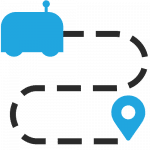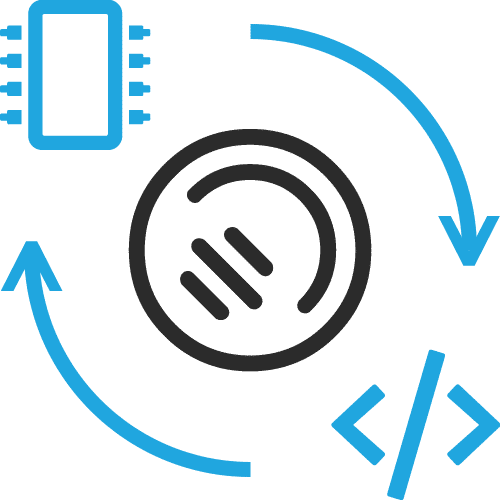JACK-SLAM
VISUAL 3D POSITIONING SYSTEM
Based only on the existing features of the venue, it localizes in real-time any mobile device, like AMR, AGV, forklifts, drones, service robots.
WHAT IS JACK SLAM?

JACK SLAM © is a visual positioning system using only classic cameras to provide an accurate location to all types of robots: AGV, forklifts, drones, service robots, and all automated vehicles.

JACK SLAM © use the Visual SLAM technology, the latest state-of-the-art technology to locate any mobile system indoor.

JACK SLAM ©is dedicated for an indoor usage, but it can be used also outdoor where a better accuracy than GPS is required.
It works in urban and peri-urban environment

JACK SLAM © is a software developped by ipsum tek company.
THE-JACK-BOX © is a ready-to-use box integrating JACK-SLAM © software
Highlights
COST-EFFECTIVE
JACKSLAM is a cost-effective alternative to LIDAR or UWB beacons.
With a high ROI, it can be integrated in many robotics applications for tracking in 3D any moving device.
ACCURATE AND SCALABLE
With centimeters accuracy, it build a amap that can be shared among robots.
Insensitivive to moving objects, JACK SLAM is perfect for the localization of robot’s fleet.
ROBUST LOCALIZATION
Based on Visual SLAM, a cutting-edge technology, JACK SLAM localizes a robot in real time in any situation.
With its camera turned toward the ceiling, it locates based on immutable points.
EASY TO INTEGRATE
As a ready-to-use hardware or as a software to be integrated on any existing embedded computer. Our engineers provide a powerful support.
HOW TO INTEGRATE JACK SLAM ?
The software can be integrated into any system in 2 ways:
– THE-JACK-BOX: A ready-to-use box that can be mounted on any mobile element.
– JACK-SLAM SOFTWARE : A third-party software to be integrated in a customer computer
THE-JACK-BOX
This ready-to-use box integrates the JACK-SLAM© software.
After the success of V1, we develop the next-generation (V2) using stereo cameras.
For new customers, we develop also THE-JACK-BOX-DEMO in order for them to test quickly the performances of our software in their own venues.
SPECIFICATIONS
- Real time: Position is updated at a rate of 20 results/s.
- Low cost: Nothing to install in the environment, works with standard RGB camera(s).
- Accurate: centimeters localization.
- Reliable: Cope with difficult cases such as light changes, lack of illumination, dynamic objects, texture-less scenes.
- Robust: With its cameras turned toward the ceiling, it locates with immutable points (window corners, color variations, shelves, ceiling elements, etc.)
- Insensitive to moving objects: humans, animals, other robots, etc.
- Efficient: Loop closures mechanism generating accurate maps.
- Map update: Automatic each time the the system returns to an area already visited.
- Map sharing: With all other robots of the fleet.
- Light: Works on any hardware (to get an idea it works at 25fps on a Raspberry pi4)
- Multiple inputs: monocular, stereo and depth cameras
- 6DOF: issues the position in 6DOF: X, Y, Z locations and Rx, Ry, Rz rotations.
HOW IT WORKS ?
JACK SLAM uses the images of the natural landmarks of the places in which it evolves.
In each image, the algorithm identifies 100 to 200 particular points such as window corners, color variations, shelves, ceiling elements, etc. Thus, from image to image the algorithm tracks these points and calculates the instantaneous position of the mobile on which the JACK-SLAM is mounted.
In the video we see what JACK-SLAM is seeing. The green points are the features it takes to perform the localization.
We can see JACK SLAM in action. Its camera is turned at 70° towards the ceiling and 20° forward:
This is an ideal inclination for a localization performed with landmarks on the ceiling and the tops of the walls.
In this video, we also see that direct lights do not affect the localization.
Videos
Mounted on an industrial cleaning machine
In this video, JACK-SLAM is embedded on an industrial cleaning machine.
It runs in a 20,000m2 supermarket with its camera fully turned towards the ceiling.
It uses a single RGB camera 640×480.
Video is accelerated for convenience.
After having done 400m, JS comes back to a zone already mapped:
We can notice at this moment that the precision before this loop closure is excellent (about 10m difference) and that the map becomes consistent once the loop is closed.
In Challenging environments
To test the system in challenging situations, we use photo-realistic simulation environments with camera mounted on an aerial vehicle. These environments permit also to show the ability of JACK-SLAM to localize in 3 dimensions.
THE-JACK-BOX-DEMO hand-held in an office
Application in an office where the box sends results on a PC running the SurvEye software.
WHAT MAKES JACK SLAM DIFFERENT FROM OTHER POSITIONING PRODUCTS
It can relocate in less than a second (for example if the system is suddenly brought anywhere in its map).
It continues to work perfectly even if the environment has completely changed (for example a warehouse has been totally restructured).
It needs little to provide efficient localization: A simple 4-core CPU and low-cost cameras.
WHERE TO USE IT
Wherever an accurate indoor location is needed.
To locate any moving element in 3D within a few centimeters.
Industry.
Logistics and Assembly plants.
Public places (hospitals, museums, airports, …).
Supermarkets and Retail stores.
Offices.
Security.
Private house.
Research Labs.
Retirement homes.
Exhibitions and Shows.
Hotels and Restaurants.
Robots in city
FAQ
SLAM (Simultaneous Localization And Mapping) is the way to locate a device indoor.
The ability to build a map and simultaneously localize within that map is essential in all robotic applications. The input sensor for SLAM is traditionally a LIDAR.
Visual SLAM (VSLAM) uses a mono or stereo camera as input to localize, so a low cost sensor.
JACK SLAM is a VSLAM.
This technology, much more efficient than LIDAR in many cases, is old but has never been able to have a practical use because of the important CPU resources required. Today, both powerful and inexpensive hardware and the optimizations made by ip sum tek allow the use of VSLAM in real time on low cost computers.
The principle to locate is like the one used by humans: Detecting the natural features seen by the camera (a difference in color, an angle, a shape, …). Have a look to the videos of this site to understand the principle.
The easiest way to test the JACK SLAM positioning system is to purchase a JACK-BOX-DEMO.
This box, with a calibrated camera, computer and battery is ready to use. You can use it handheld and walk around, it will locate you. Or you can temporarily install it on any mobile system (a better way to test it in-situ).
The location is transmitted via Wi-Fi and you can see the result immediately on a PC with the supplied software (the result is localization in real time).
Both.
ip sum tek provides THE-JACK-BOX, a hardware that can be directly mounted in any robot (with any power supply ranging from 9V to 60VDC) and -but not necessarily- interfaced with any navigation system.
ip sum tek also provides a software that can be integrated in embedded computer using Linux as OS.
Both are sold on license-based: 1 robot = 1 license.
There are 2 cases where a VSLAM may not work perfectly:
– Less textured scenes (example: a white wall fills the entire field of view of the camera)
– In total darkness
But these 2 cases can be overcome.